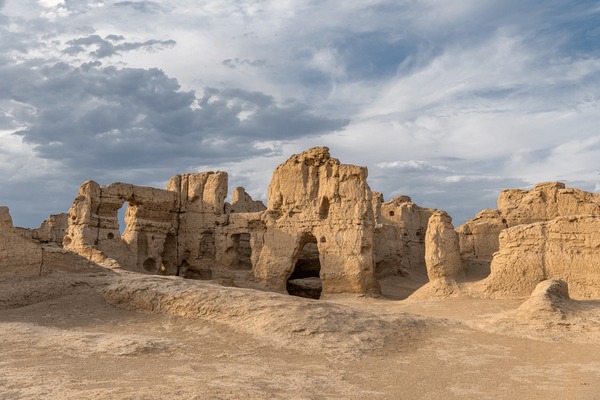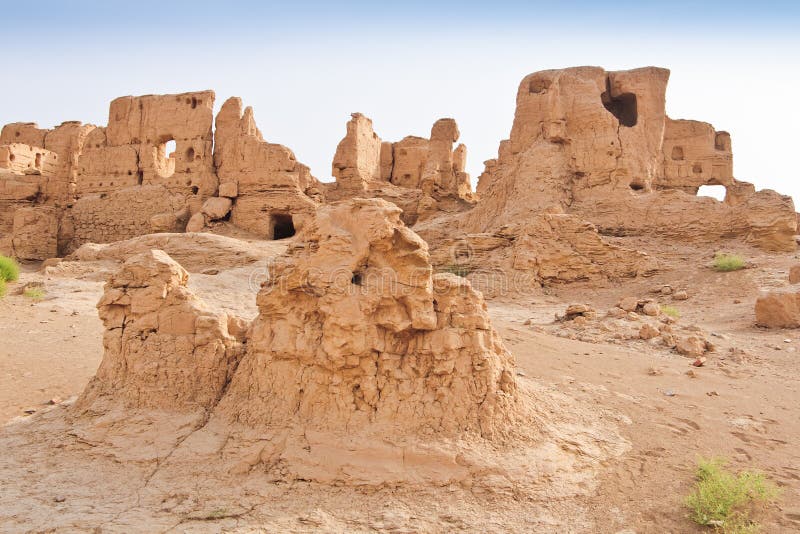Step Back in Time at Cishan Ruins: Exploring China’s Ancient Heritage

An Essential Guide to Visiting Cishan Ruins
In This Guide
- An Essential Guide to Visiting Cishan Ruins
- The Rich History and Legends of Cishan Ruins
- Main Highlights: What You Absolutely Can’t Miss
- Planning Your Visit: A Practical Guide
- Tickets: Prices, Booking, and Tips
- How to Get There: A Complete Transportation Guide
- Local Cuisine and Accommodation Nearby
- Frequently Asked Questions
- Final Thoughts on Your Trip
Nestled in the verdant hills of Cishan, the Cishan Ruins (磁山遗址) present an intriguing glimpse into one of the earliest human settlements in China, dating back approximately 7,000 years. This site, often overshadowed by the more famous Terracotta Warriors and the Great Wall, offers a unique opportunity for those eager to delve deeper into the rich tapestry of Chinese history and culture. As you wander through the remnants of ancient dwellings, pottery kilns, and agricultural fields, you’ll find that the Cishan Ruins are not just a testament to the resilience and ingenuity of early human civilization, but also a canvas that paints a vivid picture of life during the Neolithic period in China.
Visiting the Cishan Ruins is an experience that invites reflection and discovery. The site is located in the Shaanxi province, a region steeped in historical significance and natural beauty. Here, you can explore the delicate balance between man and nature, observing how the ancient inhabitants adapted to their surroundings to cultivate crops and create intricate pottery that would lay the foundation for future Chinese dynasties.

Cishan Ruins.
For the international traveler, the Cishan Ruins are more than just a stop on a historical tour; they are an invitation to connect with the past in a way that is both intimate and profound. As you embark on your journey to this remarkable site, prepare to be captivated by the stories of those who walked these grounds long before us, and to gain a deeper appreciation for the cultural heritage that continues to shape China today.
Join us as we guide you through an essential visit to the Cishan Ruins, highlighting what to see, how to prepare, and the cultural insights that will enrich your experience.

Cishan Ruins.
The Rich History and Legends of Cishan Ruins
Unveiling the Mystique of Cishan Ruins
Nestled in the heart of China’s Henan Province, the Cishan Ruins (磁山遗址) represent a fascinating tapestry of ancient history and legend. As one of the earliest Neolithic sites discovered in China, Cishan offers a glimpse into a civilization that thrived as far back as 6,000 years ago. The significance of these ruins lies not only in their age but also in their role as a critical chapter in the narrative of early Chinese culture.
A Glimpse into the Past
Cishan is renowned for its unique pottery, characterized by its black or gray color and intricate designs. Archaeologists believe that the inhabitants of Cishan were among the first to develop advanced pottery techniques, which played a pivotal role in their daily lives. These artifacts, often adorned with geometric patterns, demonstrate a sophisticated understanding of both aesthetics and functionality.

Cishan Ruins.
The site itself is a treasure trove of archaeological finds, including remnants of residential structures, tools, and food storage facilities. These discoveries provide invaluable insights into the lifestyle, diet, and social organization of the Cishan people. Evidence suggests that they engaged in agriculture, cultivating millet and other crops, which laid the foundation for future Chinese agricultural practices.
Legends and Lore
Beyond the physical remnants, the Cishan Ruins are steeped in legends that have transcended generations. One of the most captivating tales is that of the “Cishan People and the Dragon.” According to local folklore, the ancient inhabitants made a pact with a benevolent dragon spirit that resided in the nearby river. This spirit was believed to protect their harvests and ensure bountiful yields in exchange for offerings of pottery and food. The dragon became a symbol of prosperity and a revered figure in the community, illustrating the deep connection between the Cishan people and their natural environment.
Another legend speaks of the “Three Sisters of Cishan,” who were said to possess extraordinary skills in pottery making. According to this tale, the sisters were tasked with creating vessels that could withstand the fiercest of storms. Their craftsmanship was so remarkable that it attracted the attention of neighboring tribes, leading to trade and cultural exchange that enriched the region. This story not only highlights the artistic prowess of the Cishan people but also underscores the importance of community and collaboration in ancient Chinese society.

Cishan Ruins.
The Legacy of Cishan
Today, the Cishan Ruins stand as a testament to the ingenuity and resilience of one of China’s earliest cultures. Visitors to the site can wander through the remnants of ancient homes, marvel at the craftsmanship of pottery, and immerse themselves in the rich history that permeates the landscape. The surrounding area has been developed into an archaeological park that offers educational resources and guided tours, making it accessible for travelers eager to connect with the past.
As you explore the Cishan Ruins, you will not only witness the remnants of an ancient civilization but also feel the echoes of legends that have been woven into the fabric of Chinese culture. This site stands as a bridge between the past and the present, inviting all who visit to reflect on the enduring significance of history and heritage in shaping our modern world.

Cishan Ruins.
Whether you are an avid historian, a culture enthusiast, or simply in search of an off-the-beaten-path destination, the Cishan Ruins offer a compelling journey into the heart of ancient China.
Main Highlights: What You Absolutely Can’t Miss
Unveiling the Mysteries of Cishan Ruins: Essential Highlights
The Cishan Ruins (磁山遗址) offer a captivating glimpse into ancient Chinese civilization, marking one of the most significant archaeological sites in the country. As an international traveler with a keen interest in history and culture, here are the main highlights you absolutely can’t miss during your visit to this remarkable site.

Cishan Ruins.
1. Archaeological Significance
The Cishan Ruins are renowned for their historical importance, dating back approximately 6,000 years to the Neolithic period. This site gives insight into the early agricultural practices of the Chinese civilization, showcasing the development of rice cultivation and pottery-making. Take the time to appreciate the intricate artifacts unearthed here, including beautifully crafted pottery that reflects the artistic skills of ancient peoples.
2. The Cishan Culture Museum
Adjacent to the ruins, the Cishan Culture Museum is a must-visit for anyone eager to delve deeper into the history and artifacts from the site. The museum presents a rich collection of exhibits that display the life and culture of the inhabitants during the Neolithic era. Interactive displays and detailed descriptions will enhance your understanding of how the Cishan people lived, worked, and thrived.

Cishan Ruins.
3. The Ancient Agricultural Terraces
One of the standout features of the Cishan Ruins is the ancient agricultural terraces that illustrate the advanced farming techniques employed by early Chinese civilizations. Walking along these terraces, you can envision the landscapes of the past, where farming was not just a necessity but an art form. These terraces also offer picturesque views of the surrounding countryside, perfect for photography enthusiasts.
4. Excavation Sites
Witness the ongoing archaeological work at the excavation sites within the Cishan Ruins. Depending on the time of your visit, you might catch a glimpse of archaeologists carefully uncovering artifacts and studying the layout of ancient settlements. This experience adds a dynamic element to your understanding of the site’s historical context and significance.

Cishan Ruins.
5. Stunning Natural Surroundings
Beyond the historical significance, the Cishan Ruins are set against a backdrop of stunning natural beauty. The lush greenery and rolling hills surrounding the site make for a peaceful retreat from the hustle and bustle of urban life. Take a leisurely stroll through the area and enjoy the tranquility that has enveloped this site for millennia.
6. Local Cultural Experiences
Immerse yourself in the local culture by exploring nearby villages. Engage with local artisans who may still practice traditional crafts similar to those of the ancient Cishan inhabitants. Sampling regional cuisine is another enriching experience—look for dishes that incorporate local ingredients and reflect the agricultural heritage of the area.

Cishan Ruins.
7. Photography Opportunities
The Cishan Ruins and their surrounding landscapes offer incredible opportunities for photography. Capture the beauty of ancient structures, the vibrant colors of local flora, and the daily life of residents in nearby villages. Whether you’re a professional photographer or a casual snapper, you’ll find endless inspiration that tells the story of this historic site.
8. Guided Tours
Consider joining a guided tour to fully appreciate the historical context and significance of the Cishan Ruins. Knowledgeable guides can provide fascinating insights and anecdotes about the site that you might miss on your own. Look for tours that combine visits to other historical sites in the area for a comprehensive experience.
Conclusion
A visit to the Cishan Ruins is not just a journey through ancient history; it’s an exploration of human ingenuity and cultural evolution. From the archaeological significance to the stunning natural surroundings, every aspect of this site invites you to immerse yourself in the rich tapestry of Chinese heritage. Be sure to allocate ample time to discover the layers of history that make the Cishan Ruins an unmissable highlight in your travels through China.

Cishan Ruins.
Planning Your Visit: A Practical Guide
Getting to the Cishan Ruins
Location and Accessibility
The Cishan Ruins, located in the northern part of Shandong Province, are not only historically significant but also relatively accessible from major cities such as Jinan and Qingdao. If you’re flying into China, consider booking a flight to either of these cities, then taking a high-speed train or local bus to reach Cishan.
Travel Tips:
– Direct Flights: While direct flights to Jinan may be limited depending on your departure city, it’s advisable to connect through major hubs like Beijing or Shanghai for the best deals.
– Public Transport: Once in Shandong, the high-speed train network is efficient and comfortable, making it easy to navigate to smaller towns near the ruins.

Cishan Ruins.
Best Time to Visit
Optimal Seasons
The ideal time to explore the Cishan Ruins is during the spring (April to June) and autumn (September to November) when the weather is mild, and the surrounding landscapes are particularly beautiful. This timing not only provides pleasant temperatures for outdoor explorations but also allows you to experience local festivals that celebrate the region’s rich cultural heritage.
What to Expect at the Cishan Ruins
Historical Significance
Cishan is a key archaeological site featuring remnants from the Neolithic era, including ancient pottery and tools that provide insight into early agricultural practices in China. As you wander through the site, expect to see a variety of excavated structures that showcase the ingenuity of early Chinese civilization.

Cishan Ruins.
Visitor Experience:
– Guided Tours: To fully appreciate the historical context, consider joining a guided tour. Local guides often share fascinating narratives and insights that elevate your understanding of the site.
– Interactive Exhibits: Look out for interactive displays that allow you to engage with the artifacts and learn through hands-on experiences.
Preparing for Your Visit
What to Bring
– Comfortable Footwear: The site involves a fair amount of walking, so wear sturdy shoes.
– Sun Protection: Depending on the season, sunscreen and a wide-brimmed hat can be essential, especially if you’re visiting in summer.
– Water and Snacks: There may be limited food options at the site, so pack some refreshments to keep your energy up.
Photography
The Cishan Ruins offer stunning landscapes and unique perspectives of ancient architecture. Be sure to bring your camera or smartphone to capture the beauty of the site, but remember to check for any photography restrictions in certain areas.
Nearby Attractions
After exploring the ruins, consider extending your trip to visit nearby attractions:
- Qufu: The birthplace of Confucius, home to the Confucius Temple and the Confucius Family Mansion.
- Mount Tai: A UNESCO World Heritage site, perfect for hiking and immersing yourself in natural beauty.
- Jinan’s Springs: Known for its picturesque Baotu Spring Park, a great place to unwind after your historical explorations.
Cultural Etiquette
Basic Chinese Phrases
Familiarize yourself with a few common phrases to enhance your interactions:
– 你好 (Nǐ hǎo) – Hello
– 谢谢 (Xièxiè) – Thank you
– 再见 (Zàijiàn) – Goodbye
Respect Local Customs
When visiting historical sites, it’s essential to be respectful. Maintain a moderate volume, avoid touching artifacts, and follow any guidelines provided by your guides or signage.
Final Thoughts
The Cishan Ruins offer an incredible opportunity to delve into China’s ancient past. With proper planning and an open mind, your visit to this remarkable archaeological site will not only be enriching but also a highlight of your journey through China’s vast historical landscape. Whether you’re a history buff or simply curious about Chinese culture, the Cishan Ruins will leave a lasting impression.
Tickets: Prices, Booking, and Tips
When planning your visit to the Cishan Ruins (磁山遗址), it’s essential to understand the ticketing process, pricing, and some handy tips to enhance your experience.
Ticket Prices
- General Admission: The entry fee for the Cishan Ruins is typically around ¥60 (approximately $9 USD). This price may vary slightly based on the season or special exhibitions.
- Discounted Tickets: Students, seniors, and children may qualify for reduced rates. Always check for proof of eligibility to secure these discounts.
- Free Entry Days: Occasionally, the site may host free entry days, especially during cultural festivals or national holidays. Keep an eye on local announcements to take advantage of these opportunities.
Booking Your Tickets
- On-site Purchase: Tickets can be purchased at the entrance of the Cishan Ruins. However, during peak tourist seasons, it’s advisable to arrive early to avoid long queues.
- Online Booking: For convenience, consider booking your tickets online through authorized travel websites or the official Cishan Ruins site. This option not only saves time but may also offer special discounts or packages.
- Group Discounts: If you’re traveling with a group, inquire about group rates when booking. Many sites offer reduced prices for larger parties.
Tips for Your Visit
- Bring Your Passport: As a foreign traveler, carrying your passport is essential. Some sites in China require identification for entry, so be prepared to show it when purchasing your ticket.
- Plan Your Visit: Allocate sufficient time to explore the Cishan Ruins. Given its historical significance, a visit can easily take 2-3 hours. Consider joining a guided tour for deeper insights into the ruins and their relevance in Chinese history.
- Check Opening Hours: Generally, the Cishan Ruins are open from 8:00 AM to 6:00 PM. However, it’s wise to verify these hours before your trip, as they may change seasonally or due to special events.
- Dress Comfortably: The site involves some walking, so wear comfortable shoes. Also, consider the weather; packing light layers can help you stay comfortable throughout the day.
- Stay Hydrated: Bring water, especially during warmer months. While there may be vendors nearby, having your own supply ensures you stay refreshed as you explore.
By understanding the ticketing process and following these tips, your visit to the Cishan Ruins can become a memorable journey into the depths of China’s rich history and culture. Enjoy your exploration of this fascinating site!
How to Get There: A Complete Transportation Guide
Getting to Cishan Ruins: Your Essential Transportation Guide
Exploring the ancient Cishan Ruins (磁山遗址) is a must for history enthusiasts visiting China. Nestled in the enchanting landscape of Shaanxi Province, this archaeological site offers a unique glimpse into early Chinese civilization. To ensure your journey is smooth and enjoyable, here’s a comprehensive transportation guide to help you reach this historic gem.
Arriving in Shaanxi Province
Air Travel:
The nearest major airport to Cishan Ruins is Xi’an Xianyang International Airport (XIY), one of China’s busiest airports. While direct flights may not be available from all international locations, many travelers find it convenient to fly into Xi’an via Beijing or Shanghai. Round-trip fares can be quite affordable, often hovering around $500 USD from major cities like Seattle, thanks to competitive airlines like Hainan Airlines.
Tip: Check for airlines offering good legroom and in-flight amenities, as comfort can enhance your travel experience.
Transportation from the Airport:
Upon landing in Xi’an, you have several options to reach Cishan Ruins:
-
Airport Shuttle Bus: This is a budget-friendly option, with regular services connecting the airport to various points in Xi’an. Look for routes heading to the Xi’an Railway Station, where you can catch a train or bus to your destination.
-
Taxi or Ride-Sharing Services: Taxis are readily available outside the airport terminal. Expect a fare of approximately 200-300 RMB (about $30-45 USD) to downtown Xi’an. Ride-sharing apps like Didi are also popular and can be a convenient alternative.
Traveling from Xi’an to Cishan Ruins
Once you have reached Xi’an, the next step is to make your way to the Cishan Ruins. Here are your best transportation options:
- By Train:
- Xi’an to Cishan Station: Board a train from Xi’an Railway Station to Cishan Station. The journey typically takes around 1-1.5 hours. Trains run frequently, but it’s wise to check the schedule in advance.
-
From Cishan Station: Upon arrival, you may need to take a short taxi ride (approximately 15-20 minutes) to reach the ruins.
-
By Bus:
- Long-Distance Buses: Direct buses to Cishan are available from Xi’an’s main bus stations, such as the Xi’an Tourist Bus Station. The bus ride can take about 1.5 to 2 hours, depending on traffic conditions.
-
Local Buses: If you prefer a more local experience, you might find smaller buses that offer routes to nearby towns, though these may take longer and require additional transfers.
-
By Private Car or Tour:
- For those looking for convenience, consider booking a private car or joining a guided tour. This option allows for a more personalized experience and can include stops at other cultural sites along the way.
Navigating Cishan Ruins
Once you arrive at Cishan Ruins, the site is relatively easy to navigate. On-site facilities may include:
- Visitor Center: Here, you can find maps and information about the ruins, as well as restrooms and refreshments.
- Guided Tours: Consider joining a guided tour for deeper insights into the historical significance of the ruins and the surrounding area.
Final Tips for Your Journey
- Keep Your Passport Handy: As with many attractions in China, you may be required to present your passport for entry.
- Language Considerations: While many signs are in English, having a translation app can be helpful when communicating with locals or reading public transport information.
- Plan Ahead: Given the varying travel times and options, it’s advisable to plan your itinerary in advance, allowing for flexibility to explore other nearby sites.
With this transportation guide in hand, you’re well-equipped to embark on a memorable journey to the Cishan Ruins and immerse yourself in the rich tapestry of Chinese history and culture. Safe travels!
Local Cuisine and Accommodation Nearby
Experience Local Flavors and Cozy Stays Near the Cishan Ruins
Visiting the Cishan Ruins, a magnificent testament to ancient Chinese civilization, is just the beginning of your cultural journey. To fully immerse yourself in the experience, don’t miss out on the local cuisine and charming accommodation options that the area has to offer. Here’s your guide to savoring the tastes of history while enjoying a comfortable stay.
Culinary Delights
Cishan, located in the heart of Shaanxi Province, is surrounded by a rich tapestry of flavors that reflect the region’s agricultural bounty and culinary traditions. Here are some must-try dishes and local eateries:
-
Biang Biang Noodles (油泼面)
Famous for its wide, hand-pulled noodles, Biang Biang Noodles is a local specialty. Look for a nearby stall where you can watch as they prepare the noodles and serve them with a spicy sauce and fresh vegetables. The dish is both filling and flavorful. -
Roujiamo (肉夹馍)
Often referred to as the Chinese hamburger, Roujiamo consists of a savory meat filling, typically braised pork or beef, stuffed in a flatbread. This street food is perfect for a quick bite while exploring the area. -
Shaanxi-style Dumplings (水饺)
Known for their delicate wrappers and generous fillings, these dumplings are a staple in Shaanxi cuisine. Seek out a local restaurant that specializes in dumplings, where you can enjoy them steamed or boiled, accompanied by tangy dipping sauces. -
Yangrou Paomo (羊肉泡馍)
This traditional lamb soup served with crumbled bread is a must-try. The rich broth and tender meat create a hearty and comforting dish. You can find cozy eateries near the ruins that serve this local favorite. -
Street Food
Don’t overlook the vibrant street food scene! Sample skewered meats, savory pancakes, and sweet treats from vendors. The atmosphere is lively, and the flavors are authentic—perfect for adventurous eaters.
Cozy Accommodations
After a day of exploring the Cishan Ruins and indulging in local delicacies, retreat to a comfortable place to rest. Here are some recommended accommodations nearby:
-
Cishan Heritage Hotel
Located within walking distance of the ruins, this hotel offers a blend of modern comfort and traditional decor. Guests can enjoy spacious rooms, a lovely garden, and a restaurant serving local cuisine. The attentive staff is eager to share insights about the area. -
Shaanxi Guesthouse
This charming guesthouse provides a cozy atmosphere with personalized service. It features well-appointed rooms and a communal area where travelers can share stories and experiences. Breakfast options include local favorites, ensuring you start your day right. -
Ancient Town Inn
Situated in a nearby ancient town, this inn boasts stunning views of the surrounding landscapes. The architecture reflects traditional Chinese styles, and the owners often host cultural activities. You can enjoy a peaceful night’s sleep and wake up to the sounds of nature. -
Hostel Xian
For budget-conscious travelers, this hostel offers dormitory-style accommodations and private rooms. It’s a great place to meet fellow travelers and share tips about the best local spots. The friendly atmosphere makes it easy to connect with others while enjoying a laid-back stay.
Final Thoughts
Your journey to the Cishan Ruins will be enhanced by the local flavors and warm hospitality of the area. Whether you’re indulging in hearty Shaanxi dishes or resting in a cozy inn, every experience will deepen your appreciation for this remarkable region’s history and culture. Enjoy your culinary adventure and restful stay as you explore the ancient wonders of China!
Frequently Asked Questions
Frequently Asked Questions about the Cishan Ruins (磁山遗址)
1. What are the Cishan Ruins?
The Cishan Ruins are an ancient archaeological site located in the Shaanxi province of China, known for their significance in early Chinese civilization. Dating back to the Neolithic period, these ruins provide valuable insights into the agricultural practices, pottery, and social structures of early societies in this region.
2. How do I get to the Cishan Ruins?
The easiest way to reach the Cishan Ruins is by taking a bus or taxi from Xi’an, which is approximately 50 kilometers away. For those interested in a more scenic route, consider renting a car or joining a guided tour that includes transportation to the site.
3. What can I expect to see at the Cishan Ruins?
Visitors to the Cishan Ruins can explore the remnants of ancient dwellings, pottery kilns, and burial sites. The site is not only an archaeological treasure but also offers a glimpse into the daily lives of the people who inhabited this area thousands of years ago. Don’t miss the opportunity to see the unique pottery styles that originated here.
4. Is there an entrance fee to visit the Cishan Ruins?
Yes, there is a small entrance fee to visit the Cishan Ruins. It’s advisable to check the current ticket prices and any potential discounts for students or group visits on the official site or through local tourism offices before planning your trip.
5. Are there guided tours available at the Cishan Ruins?
Yes, guided tours are available at the Cishan Ruins, providing deeper insights into the archaeological significance of the site. These tours are often led by knowledgeable guides who can share fascinating stories and context that enhance your understanding of the ruins.
6. What is the best time to visit the Cishan Ruins?
The best time to visit the Cishan Ruins is during the spring (April to June) and autumn (September to November) months when the weather is pleasant, and the landscapes are particularly beautiful. Avoiding the peak summer heat will make your exploration more enjoyable.
7. Are there facilities available for visitors at the Cishan Ruins?
While the site is primarily focused on archaeology, there are basic facilities available, including restrooms and a small visitor center. However, amenities may be limited, so it’s a good idea to bring water, snacks, and sun protection, especially if you plan to spend an extended period at the site.
8. Can I take photographs at the Cishan Ruins?
Yes, photography is generally allowed at the Cishan Ruins. However, be respectful of the site and its significance. Avoid using flash in sensitive areas, and consider the impact of your photography on other visitors’ experience. Always check for any specific rules regarding photography upon arrival.
Final Thoughts on Your Trip
As you conclude your journey through the Cishan Ruins and the captivating landscapes of Shaanxi Province, reflect on the remarkable blend of history, culture, and culinary delight that this region offers. The Cishan Ruins, with their intricate layers of ancient civilization, are a testament to China’s rich heritage, inviting you to ponder the lives of those who walked these grounds millennia ago.
Embrace the Experience
Shaanxi is a treasure trove of experiences waiting to be uncovered. Whether you marveled at the Giant Wild Goose Pagoda, explored the intricate Terracotta Warriors, or indulged in the culinary delights of the Muslim Quarter, each moment adds a vibrant thread to the tapestry of your travels.
Take Away the Essence of China
- History: The remnants of the past are interwoven with the present, reminding us of the enduring legacy of ancient cultures.
- Culture: From breathtaking performances of traditional Chinese ballet to vibrant street markets, every experience offers a glimpse into the heart of Chinese life.
- Cuisine: The diverse flavors of authentic Chinese cuisine will linger in your memory long after you leave, beckoning you to return for more.
A Journey of Discovery
Your adventure through the Cishan Ruins and beyond is not just a visit; it’s a journey of discovery. As you return home, carry with you the stories of the ancient, the flavors of the vibrant, and the spirit of a culture that continues to thrive. Allow these memories to inspire your future travels, igniting a passion for exploration and understanding of the world’s diverse histories and cultures.
Whether you are a history enthusiast, a culinary adventurer, or a cultural explorer, Shaanxi Province has something to offer everyone. Until your next adventure, may your travels be filled with curiosity and wonder!